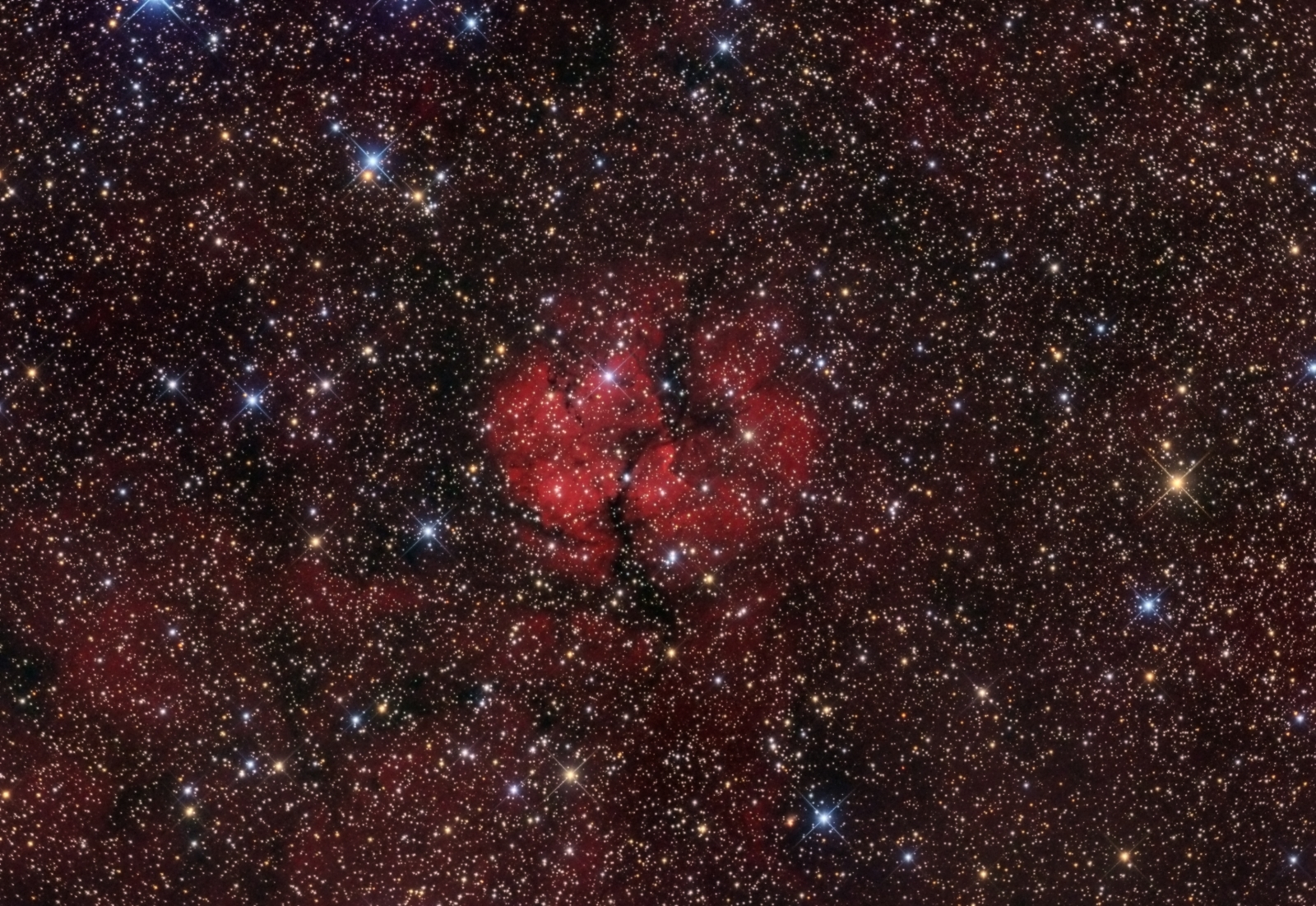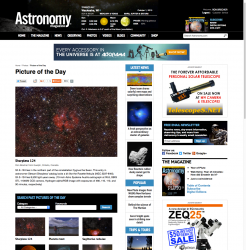Sh2-124 Emission Nebula (Colour)
 Click image for full size version
Click image for full size version
July 13, 2015, Astronomy Magazine Online Picture of the Day, Oct 1 2015; Chinese National Astronomy Magazine, December 2015

 Sh2-124 is a member of the Sharpless catalogue of nebulae. It lies in northern Cygnus, and is around 8, 500 light years away. It doesn’t seem to be imaged very often, and I was not able to find much additional information about it. Sure is pretty though. Almost look like it is being split apart. Between poor weather and shortening nights, it took more than 2 months for me to acquire all the data used for this image. This image blends the typical red, green and blue colour channels with data collected through the deep red Hydrogen-alpha filter. This object also looks beautiful in black and white.
Sh2-124 is a member of the Sharpless catalogue of nebulae. It lies in northern Cygnus, and is around 8, 500 light years away. It doesn’t seem to be imaged very often, and I was not able to find much additional information about it. Sure is pretty though. Almost look like it is being split apart. Between poor weather and shortening nights, it took more than 2 months for me to acquire all the data used for this image. This image blends the typical red, green and blue colour channels with data collected through the deep red Hydrogen-alpha filter. This object also looks beautiful in black and white.
Although it is true that black and white images can show sometimes reveal more detail than colour, it can’t show how different the stars are from each other. This image is set in the portion of the Milky Way that runs through Cygnus, and so it is chock full of stars of every hue from blue to red (there are no green stars, though there are green non-stellar objects).
Tekkies:
SBIG STL-11000M camera, Baader Ha, R, G and B filters, 10″ f/6.8 ASA astrograph, Paramount MX. Guided with STL-11000’s external guider and 80 mm f/6 Stellar-Vue refractor. Acquisition and guiding with TheSkyX. Focusing with FocusMax. Automation with CCDCommander. Calibration, cosmetic correction, registration, integration and all processing in PixInsight. Shot from my SkyShed in Guelph, Ontario. Nearly full Moon for Ha and no moon for RGB. Good to very good transparency and good to very good seeing throughout acquisition.
24x20m Ha, 11x10m R, 11x10mG and 9x10mB unbinned frames (total=13hr10m).
Initial Processing:
Ha, R, G and B masters were cropped and processed separately with DBE.
HaRGB
R, G and B were combined to make an RGB image which was processed with DBE and ColourCalibration. The NB-RGBCombine Script was applied with default settings to produce a linear HaRGB image. MultiscaleLinearTransform was used to reduce noise in the background areas. HistogramTransformation was applied to make a pleasing yet bright image. TGV Noise was applied and the image was re-stretched to reset the black point.
Synthetic Luminance:
Creation and cleanup: The cleaned up Ha, R,G and B masters were combined using the ImageIntegration tool (average, additive with scaling, noise evaluation, iterative K-sigma / biweight midvariance, no pixel rejection).
Deconvolution: A copy of the image was stretched to use as a deconvolution mask. A star mask was made from unstretched L to use as a local deringing support. Deconvolution was applied (125 iterations, regularized Richardson-Lucy, external PSF made using DynamicPSF tool with about 20 stars; local deringing at 70% and global dark deringing at 0.02).
Linear Noise Reduction: MultiscaleLinearTransform was applied to reduce the noise.
Stretching: HistogramTransformation was applied to make a pleasing yet bright image. TGV Noise was applied and the image was re-stretched to reset the black point.
Combining SynthL with HaRGB:
The luminance channel of the HaRGB image was extracted, processed and then added back into the HaRGB image as follows:
1. Extract luminance from the HaRGB image.
2. Apply LinearFit using SynthL as the reference.
3. Use ChannelCombination in Lab mode to replace the HaRGB’s luminance with the fitted luminance from step 2.
4. LRGBCombine was then used to make a SynthLHaRGB image.
Final Processing
HistogramTransformation was used to reset the black point and grey point. Then a range mask was produced that allowed used to slightly increase the brightness of the nebula. Then overall contrast was increased and brightness increased slightly with the Curves tool.
Star shapes were smoothed and sizes reduced by applying MorphologicalTransformation twice through the same star mask. The first pass used the Midpoint operator, with default settings. The second pass used the Erosion operator with a strength of 0.25 and 4 iterations.
The DarkStructureEnhance script was applied with default settings except a strength of 0.2. ExponentialTransformation was applied to the fainter parts of the image, with stars protected with a mask. UnsharpMask was applied to the brightest parts of the nebula. A curve was applied to increase contrast, followed by a final pass of UnsharpMask on the stars.
Image scale is about 1.1 arcsec per pixel for this camera / telescope combination.






Leave A Comment